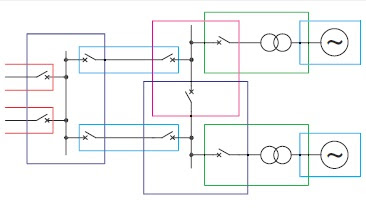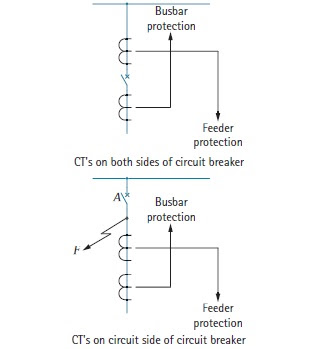Zoning in Power system Protection is an important philosophy and must be done carefully so that no part of the system remains unprotected in any condition. To limit the extent of the power system that is disconnected when a fault occurs, protection is arranged in zones. The principle is shown in figure below.
For practical physical and economic reasons, this ideal zoning in protection is not always possible to achieve because accommodation for current transformers being in some cases available only on one side of the circuit breakers, as shown in figure below.
This leaves a section between the Current Transformers and Circuit Breaker CB-A that is not completely protected against faults. As shown in figure above, a fault at F would cause the busbar protection to operate and open the circuit breaker but the fault may continue to be fed through the feeder. The feeder protection, if of the unit type, would not operate, since the fault is outside its zone. This problem is dealt with by intertripping or some form of zone extension, to ensure that the remote end of the feeder is tripped also.
The section of Power System which is not covered under any zone of protection is called Dead Zone or Blind Zone and special kind of protection shall be provided to take care of fault in Dead Zone. Normally overcurrent element is used for the protection of Dead Zone with some suitable logic interlock. The logic interlock depends on the configuration of power system and the condition in which Dead Zone is created. Let us take an example to have more insight. Carefully observe the figure below.
Transformer is fed by the Bus when the Breaker CB-A is close. Now suppose we want to take Transformer under maintenance, so for isolating the Transformer we will open CB-A and DS. After opening DS, it may be required to close the CB-A to feed some other connected feeder. As the Breaker is closed, a portion up to DS is charged. Now suppose a fault take place in between DS and CT-3. Assuming that CT-1, CT-2 and CT-3 are meant for protection of Zone in between the CTs using Differential protection, so a fault outside this zone will not be protected and hence zone in between CT-3 and DS is unprotected and called Dead Zone.
What will be the logic for implementing protection of this Dead Zone?
One may say, if the DS is open and CT-3 senses an overcurrent then Relay shall issue a tripping command to CB-A. That is all, Dead Zone is no more Dead rather it is protected. Notice that in this case Dead Zone or Blind Zone is created in a particular condition where the DS is open and CB-A is close.
Any doubt? Please ask.




Nice information
This is very educating
Thank you Atizara!
could u please elaborate fig 3, 4 n 5 and how the overlapping makes the system reliable??
Overlapping in protection zone ensures that no part of power system is unprotected. The best example to understand the importance of overlapping is in distance protection. To beeter understand, please read Why Zone-1 Setting 80% in Distance Protection?
If still you have doubt, please comment.